MERIDIAN - Today local fire departments joined at the Idaho State Capitol steps to accept Governor Brad Little’s proclamation declaring January 20-26th as Community Risk Reduction (CRR) Week in Idaho. This proclamation highlights the importance of raising awareness around the value of CRR and encourages collaboration among community members, first responders, and local agencies to reduce risks and improve overall safety in our communities.
Community Risk Reduction is recognized both nationally and locally as a vital element of the fire service. The vision behind CRR is to create healthier, safer, and more resilient communities by minimizing the frequency and impact of emergency events on both residents and emergency responders.
"As our community continues to grow and change, it’s crucial that we adapt our risk reduction strategies to meet evolving needs," said Boise Fire Assistant Chief, Romeo Gervais. "By focusing on prevention and using data informed approaches, we can address not just fire risks but a range of potential dangers, from cardiac arrest to traffic accidents."
Meridian and Boise Fire Departments Prevention and Community Risk Reduction Divisions play a central role in this initiative, working closely with stakeholders to identify gaps in community health, safety, and resilience. By analyzing data and applying critical thinking, the department makes informed decisions that help guide prevention efforts before an emergency happens.
“We often focus on the risks we can easily see, like fires,” said Meridian Fire Community Risk Reduction Division Manager. “But in looking at data, we’ve identified that risks such as falls, cardiac arrests, and motor vehicle collisions may be more frequent than structure fires, which allows us to target prevention efforts more effectively.”
As Idaho’s population grows and diversifies, the need for tailored prevention and mitigation strategies becomes even more urgent. Effective Community Risk Reduction requires a multi-faceted approach, which is why local fire departments utilize five key strategies, all beginning with the letter “E”:
Community Risk Reduction is recognized both nationally and locally as a vital element of the fire service. The vision behind CRR is to create healthier, safer, and more resilient communities by minimizing the frequency and impact of emergency events on both residents and emergency responders.
"As our community continues to grow and change, it’s crucial that we adapt our risk reduction strategies to meet evolving needs," said Boise Fire Assistant Chief, Romeo Gervais. "By focusing on prevention and using data informed approaches, we can address not just fire risks but a range of potential dangers, from cardiac arrest to traffic accidents."
Meridian and Boise Fire Departments Prevention and Community Risk Reduction Divisions play a central role in this initiative, working closely with stakeholders to identify gaps in community health, safety, and resilience. By analyzing data and applying critical thinking, the department makes informed decisions that help guide prevention efforts before an emergency happens.
“We often focus on the risks we can easily see, like fires,” said Meridian Fire Community Risk Reduction Division Manager. “But in looking at data, we’ve identified that risks such as falls, cardiac arrests, and motor vehicle collisions may be more frequent than structure fires, which allows us to target prevention efforts more effectively.”
As Idaho’s population grows and diversifies, the need for tailored prevention and mitigation strategies becomes even more urgent. Effective Community Risk Reduction requires a multi-faceted approach, which is why local fire departments utilize five key strategies, all beginning with the letter “E”:
- Education: Engaging the community through school visits, CPR classes, home wildfire assessments, fire extinguisher training, car seat installations, and other outreach efforts.
- Engineering: Installing safety equipment such as smoke alarms, fire blankets, and AEDs ensuring the proper equipment is in place when an emergency happens.
- Enforcement: Fire Marshals review building plans for new construction and renovations to ensure compliance with fire codes and life safety standards. Additionally, the Fire Marshal plays a critical role in updating fire codes to reflect modern safety standards and community needs. Prevention Captains conduct inspections of commercial occupancies to ensure adherence to fire codes, identify potential hazards, and educate business owners on fire prevention measures. These inspections are crucial in minimizing risks within workplaces and public spaces.
- Economic Incentives: Offering financial benefits, such as lower insurance premiums, for communities that improve their safety measures (e.g., achieving a lower insurance rating).
- Emergency Response: Ensuring that emergency resources are available and dispatched in a timely manner. Strategically placing fire stations to optimize response times and coverage. Training and maintaining specialized response teams, including HazMat, Technical Rescue, and Dive Teams are a critical part of CRR operations.
Community Risk Reduction Week serves as a reminder that safety is a shared responsibility. By working together and utilizing these strategies, Idaho’s communities can become more resilient and better prepared for emergencies.


About the author
Jordan Robinson
Public Information Officer